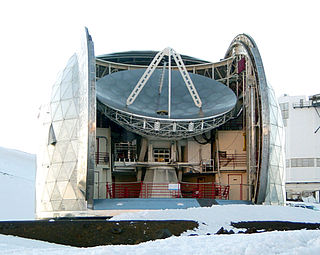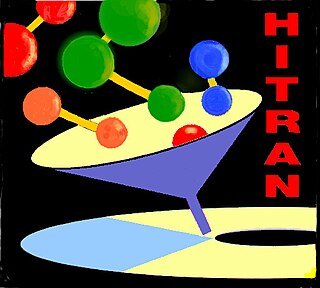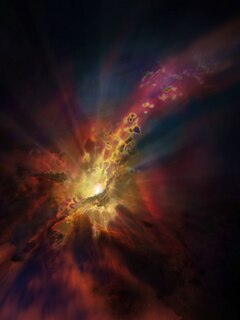Related Research Articles

Spectroscopy is the study of the interaction between matter and electromagnetic radiation as a function of the wavelength or frequency of the radiation. In simpler terms, spectroscopy is the precise study of color as generalized from visible light to all bands of the electromagnetic spectrum; indeed, historically, spectroscopy originated as the study of the wavelength dependence of the absorption by gas phase matter of visible light dispersed by a prism. Matter waves and acoustic waves can also be considered forms of radiative energy, and recently gravitational waves have been associated with a spectral signature in the context of the Laser Interferometer Gravitational-Wave Observatory (LIGO).
Astrochemistry is the study of the abundance and reactions of molecules in the Universe, and their interaction with radiation. The discipline is an overlap of astronomy and chemistry. The word "astrochemistry" may be applied to both the Solar System and the interstellar medium. The study of the abundance of elements and isotope ratios in Solar System objects, such as meteorites, is also called cosmochemistry, while the study of interstellar atoms and molecules and their interaction with radiation is sometimes called molecular astrophysics. The formation, atomic and chemical composition, evolution and fate of molecular gas clouds is of special interest, because it is from these clouds that solar systems form.
The Henry Draper Catalogue (HD) is an astronomical star catalogue published between 1918 and 1924, giving spectroscopic classifications for 225,300 stars; it was later expanded by the Henry Draper Extension (HDE), published between 1925 and 1936, which gave classifications for 46,850 more stars, and by the Henry Draper Extension Charts (HDEC), published from 1937 to 1949 in the form of charts, which gave classifications for 86,933 more stars. In all, 359,083 stars were classified as of August 2017.

Absorption spectroscopy refers to spectroscopic techniques that measure the absorption of radiation, as a function of frequency or wavelength, due to its interaction with a sample. The sample absorbs energy, i.e., photons, from the radiating field. The intensity of the absorption varies as a function of frequency, and this variation is the absorption spectrum. Absorption spectroscopy is performed across the electromagnetic spectrum.

The Atacama Large Millimeter/submillimeter Array (ALMA) is an astronomical interferometer of 66 radio telescopes in the Atacama Desert of northern Chile, which observe electromagnetic radiation at millimeter and submillimeter wavelengths. The array has been constructed on the 5,000 m (16,000 ft) elevation Chajnantor plateau - near the Llano de Chajnantor Observatory and the Atacama Pathfinder Experiment. This location was chosen for its high elevation and low humidity, factors which are crucial to reduce noise and decrease signal attenuation due to Earth's atmosphere. ALMA is expected to provide insight on star birth during the early Stelliferous era and detailed imaging of local star and planet formation.

The Sombrero Galaxy is a spiral galaxy in the constellation borders of Virgo and Corvus, being about 9.55 megaparsecs from our galaxy, within the local supercluster. It has a diameter of approximately 15 kiloparsecs, three-tenths the size of the Milky Way. It has a bright nucleus, an unusually large central bulge, and a prominent dust lane in its outer disk, which is viewed almost edge-on. The dark dust lane and the bulge give it the appearance of a sombrero hat. Astronomers initially thought the halo was small and light, indicative of a spiral galaxy; but the Spitzer Space Telescope found that the dust ring was larger and more massive than previously thought, indicative of a giant elliptical galaxy. The galaxy has an apparent magnitude of +8.0, making it easily visible with amateur telescopes, and is considered by some authors to be the galaxy with the highest absolute magnitude within a radius of 10 megaparsecs of the Milky Way. Its large bulge, central supermassive black hole, and dust lane all attract the attention of professional astronomers.

The Caltech Submillimeter Observatory (CSO) was a 10.4-meter (34 ft) diameter submillimeter wavelength telescope situated alongside the 15-meter (49 ft) James Clerk Maxwell Telescope (JCMT) at Mauna Kea Observatories. It was engaged in submillimeter astronomy, of the terahertz radiation band. The telescope closed on September 18, 2015. As of April 2019, the telescope is set to be dismantled and its site remediated in the near future as part of the Mauna Kea Comprehensive Management Plan.

The Submillimeter Array (SMA) consists of eight 6-meter (20 ft) diameter radio telescopes arranged as an interferometer for submillimeter wavelength observations. It is the first purpose-built submillimeter interferometer, constructed after successful interferometry experiments using the pre-existing 15-meter (49 ft) James Clerk Maxwell Telescope and 10.4-meter (34.1 ft) Caltech Submillimeter Observatory as an interferometer. All three of these observatories are located at Mauna Kea Observatory on Mauna Kea, Hawaii, and have been operated together as a ten element interferometer in the 230 and 345 GHz bands. The baseline lengths presently in use range from 16 to 508 meters. The radio frequencies accessible to this telescope range from 194–408 gigahertz (1.545–0.735 mm) which includes rotational transitions of dozens of molecular species as well as continuum emission from interstellar dust grains. Although the array is capable of operating both day and night, most of the observations take place at nighttime when the atmospheric phase stability is best.

The 1.2 meter Millimeter-Wave Telescope at the Harvard-Smithsonian Center for Astrophysics and its twin instrument at CTIO in Chile have been studying the distribution and properties of molecular clouds in our galaxy and its nearest neighbours since the 1970s. The telescope is nicknamed "The Mini" because of its unusually small size. At the time it was built, it was the smallest radio telescope in the world. Together, "The Mini" and its twin in Chile have obtained what is by far the most extensive, uniform, and widely used galactic survey of interstellar carbon monoxide. "The Mini" is currently in operation from October to May each year.
The Combined Array for Research in Millimeter-wave Astronomy (CARMA) was an astronomical instrument comprising 23 radio telescopes, dedicated in 2006. These telescopes formed an astronomical interferometer where all the signals are combined in a purpose-built computer to produce high-resolution astronomical images. The telescopes ceased operation in April 2015 and were relocated to the Owens Valley Radio Observatory for storage.

Submillimetre astronomy or submillimeter astronomy is the branch of observational astronomy that is conducted at submillimetre wavelengths of the electromagnetic spectrum. Astronomers place the submillimetre waveband between the far-infrared and microwave wavebands, typically taken to be between a few hundred micrometres and a millimetre. It is still common in submillimetre astronomy to quote wavelengths in 'microns', the old name for micrometre.
Mu Crucis, Latinized from μ Crucis, is the seventh-brightest star in the constellation Crux commonly known as the Southern Cross. μ Crucis is a wide double star of spectral class B stars, magnitude 4.0 and 5.2 respectively. They lie about 370 light-years away, and both stars are likely physically attached. The brighter component is known as μ1 Crucis or μ Crucis A, while the fainter is μ2 Crucis or μ Crucis B.

Associated Universities, Inc. (AUI) is a research management corporation that builds and operates facilities for the research community. AUI is a not-for-profit 501(c)(3) corporation, headquartered in Washington, DC. The President is Dr. Adam Cohen. AUI's major current operating unit is the National Radio Astronomy Observatory (NRAO), which it operates under a Cooperative Agreement with the National Science Foundation.

The ethynyl radical is an organic compound with the chemical formula C≡CH. It is a simple molecule that does not occur naturally on Earth but is abundant in the interstellar medium. It was first observed by electron spin resonance isolated in a solid argon matrix at liquid helium temperatures in 1963 by Cochran and coworkers at the Johns Hopkins Applied Physics Laboratory. It was first observed in the gas phase by Tucker and coworkers in November 1973 toward the Orion Nebula, using the NRAO 11-meter radio telescope. It has since been detected in a large variety of interstellar environments, including dense molecular clouds, bok globules, star forming regions, the shells around carbon-rich evolved stars, and even in other galaxies.

HITRAN molecular spectroscopic database is a compilation of spectroscopic parameters used to simulate and analyze the transmission and emission of light in gaseous media, with an emphasis on planetary atmospheres. The knowledge of spectroscopic parameters for transitions between energy levels in molecules is essential for interpreting and modeling the interaction of radiation (light) within different media.
Propynylidyne is a chemical compound that has been identified in interstellar space.

The cyano radical (or cyanido radical) is a radical with molecular formula CN, sometimes written •CN. The cyano radical was one of the first detected molecules in the interstellar medium, in 1938. Its detection and analysis was influential in astrochemistry. The discovery was confirmed with a coudé spectrograph, which was made famous and credible due to this detection. ·CN has been observed in both diffuse clouds and dense clouds. Usually, CN is detected in regions with hydrogen cyanide, hydrogen isocyanide, and HCNH+, since it is involved in the creation and destruction of these species (see also Cyanogen).

The Large Latin American Millimeter Array (LLAMA) is a single-dish 12 m Nasmyth optics antenna which is under construction in the Puna de Atacama desert in the Province of Salta, Argentina. The primary mirror accuracy will allow observation from 40 GHz up to 900 GHz. It is also planned to install a bolometer camera at millimeter wavelengths. After installation it will be able to join other similar instruments to perform Very Large Base Line Interferometry or to work in standalone mode. Financial support is provided by the Argentinian and Brazilian governments. The total cost of construction, around US$20 million, and operation as well as the telescope time use will be shared equally by the two countries. Construction planning started in July 2014 after the formal signature of an agreement between the main institutions involved.

Abell 2597 is a galaxy cluster located about a billion light years from Earth in the constellation of Aquarius. It is a giant elliptical galaxy that is surrounded by a sprawling cluster of other galaxies. In 2018, the National Radio Astronomy Observatory (NRAO) captured cosmic weather event using the Atacama Large Millimeter/submillimeter Array (ALMA) that has never been seen before - a cluster of towering intergalactic gas clouds raining in on the supermassive black hole at the center of the huge galaxy. The black hole draws in vast store of cold molecular gas and sprays it back again in an ongoing cycle so that it resembles a gigantic fountain.
The Utrecht Atlas of the solar spectrum is a detailed inventory in graphical form of spectral lines observed in sunlight at the Sonnenborgh Observatory. The visible spectrum is about 390 to 700 nm and the atlas covers from 361.2 to 877.1 nm so that the atlas has some coverage of the infrared and ultraviolet spectrum of sunlight. The atlas, compiled by Minnaert and his students Mulders and Houtgast, was published in 1940 shortly before the WWII invasion of the Netherlands.
The Atlas contains intensity curves covering the complete solar spectrum from λ 3612 to λ 8771 based on photographs taken at the Mount Wilson Observatory together with an appendix covering the region λ 3332 to λ 3637 as derived from plates secured at Utrecht. The scale in wave length is about 20 millimeters per angstrom so that the spectrum is represented on a map about 360 feet long. The curves are printed in black on millimeter paper with blue lines. The intensity scale is such that a vertical range of 100 millimeters corresponds to the difference between zero intensity and the continuous background.
The atlas had a huge influence on solar and stellar high resolution spectroscopy after World War II.
References
- ↑ A. J. Remijan, "Splatalogue-Motivation, Current Status, Future Plans", Bulletin of the American Astronomical Society, vol. 42, p. 568, 2010.
- ↑ A. J. Remijan, A. J. Markwick-Kemper, "Splatalogue: Database for Astronomical Spectroscopy", OSU International Symposium on Molecular Spectroscopy, 2008.
- ↑ A. J. Markwick-Kemper, A. J. Remijan, "The Splatalogue (Spectral Line Catalogue) and Calibase (Calibration Source Database)", Bulletin of the American Astronomical Society, vol. 38, p. 130, 2006.
- ↑ Remijan, Anthony; McGuire, Brett; Seifert, Nathan (2016). "The Database for Astronomical Spectroscopy - Updates, Additions and Plans for Splatalogue for Alma Full Science Operations". Proceedings of the 71st International Symposium on Molecular Spectroscopy. p. 1. doi:10.15278/isms.2016.FB11. ISBN 978-1-5330-5390-9.